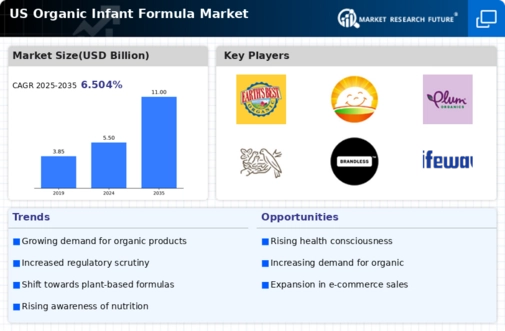Regulatory Support for Organic Products
The organic infant-formula market benefits from robust regulatory frameworks that support the production and labeling of organic products. In the US, the USDA has established stringent guidelines for organic certification, which enhances consumer trust in organic infant formulas. This regulatory support not only ensures product quality but also encourages manufacturers to invest in organic farming practices. As a result, The organic infant-formula market was projected to grow at a CAGR of 8% over the next five years, driven by increased compliance with organic standards and consumer demand for certified organic products.
Rise of E-commerce and Online Retailing
The organic infant-formula market is witnessing a transformation due to the rise of e-commerce and online retailing. With the convenience of online shopping, parents are increasingly turning to digital platforms to purchase organic infant formulas. This shift is supported by data indicating that online sales of organic products have grown by 25% in the past year alone. E-commerce platforms provide parents with access to a wider variety of organic infant formulas, often at competitive prices. This trend is likely to continue, as more consumers embrace the convenience of online shopping, thereby expanding the reach of the organic infant-formula market.
Growing Health Consciousness Among Parents
The organic infant-formula market is surging due to the increasing health consciousness among parents. Many caregivers are becoming more discerning about the nutritional content of the products they choose for their infants. This trend is reflected in the rising demand for organic ingredients, which are perceived as healthier alternatives to conventional options. According to recent data, approximately 60% of parents express a preference for organic infant formulas, indicating a significant shift in consumer behavior. This growing awareness is likely to drive innovation within the organic infant-formula market, as manufacturers strive to meet the evolving expectations of health-conscious consumers.
Increased Availability of Organic Ingredients
The organic infant-formula market is benefiting from the increased availability of organic ingredients. As more farmers adopt organic farming practices, the supply chain for organic raw materials is becoming more robust. This expansion is crucial for manufacturers, as it allows them to source high-quality organic ingredients at competitive prices. Recent statistics indicate that the availability of organic ingredients has risen by 15% in the last two years, facilitating the production of a wider range of organic infant formulas. This trend is expected to enhance product offerings in the organic infant-formula market, catering to the diverse needs of health-conscious parents.
Influence of Social Media and Parenting Communities
The organic infant-formula market is significantly influenced by social media and parenting communities. Online platforms serve as vital sources of information and recommendations for parents seeking the best nutrition for their infants. Influencers and parenting blogs often promote organic infant formulas, highlighting their benefits and driving consumer interest. This trend appears to be effective, as studies show that 70% of parents rely on social media for product recommendations. Consequently, the organic infant-formula market is likely to see increased visibility and sales as these platforms continue to shape consumer perceptions and preferences.





















Leave a Comment